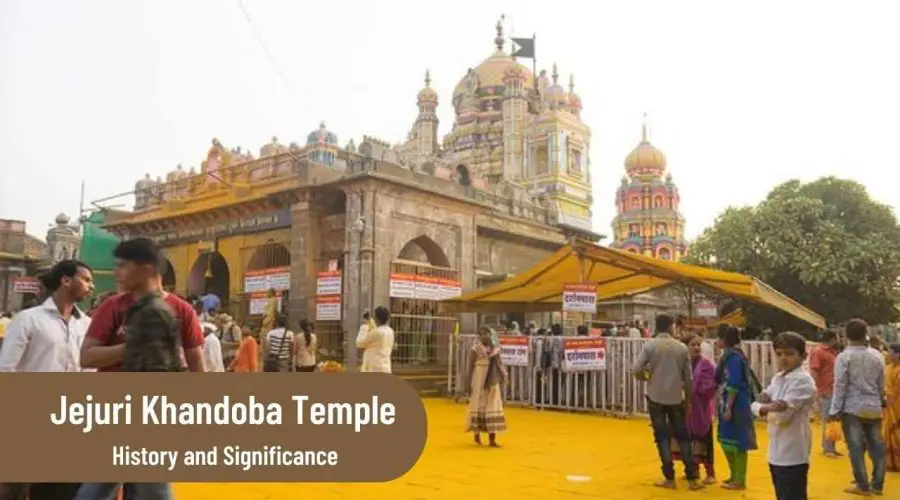Know the History and Significance of Jejuri Khandoba Temple
Jejuri Khandoba Temple is located approximately 48 km southeast of Pune, in the direction of Phaltan.
Importance of Jejuri Khandoba
A devotee must climb 200 stone steps to reach the hill top Khandoba Mandir. The Dhangar tribe, one of the oldest in Maharashtra, worships in Jejuri. They are a group of shepherds who are extremely dedicated to Khandoba (Lord Shiva) because he wed Ganai, a shepherd’s daughter.
After getting married, couples go to the shrine where they must make an offering to the deity while standing next to one another.
It is said that to defeat the demons Mani and Malla, Lord Shiva appeared as Khandoba. Khandoba’s martial emblem is called Divti. It resembles a dagger but also functions as a lamp. The dagger represents light slaying darkness when it is lit up.
History and architecture of the Jejuri Khandoba Temple
In the year 1608 AD, the temple was first built. Ragho Mambaji, a Maratha chief, finished the Sabhamandapa and other components in 1637 AD.
The Holkar kings constructed the auxiliary chambers and other expansions.
In the year 1742 AD, the pillars were erected, and in the year 1770 AD, Tukoji Holkar finished the battlements and the tank.
The main Jejuri Khandoba Mandir is situated 300 metres above the current temple complex on the mountain named Karhe Pathar.
Khandoba is typically worshipped by followers in the lower temple.
The shepherd groups who revere Khandoba as their family deity have built deepmalas, cloisters, nagarhanas, enhanced flight of steps, and other structures over the years. Many structures have been added by those whose desires have been granted.
Each extension to the old temple followed the style of Maratha architecture.
Around each corner of the temple are minarets and chhatris, and the cloisters all around have pointed stone arches with grills or windows.
The temple contains a vintage Portuguese bell and a massive 7-meter-diameter brass-plated tortoise that is used in the ritual distribution of dried coconut and turmeric.
For the fulfilment of a commitment, Nana Phadanvis, the Peshwas of Pune’s regent, offered 100,000 silver coins. These coins were transformed into ornamental mahirap and ceremonial silver representations, respectively (background).
At Jejuri, there are three collections of murtis (pictures) that display the skill of coppersmiths, jewellers, and other artisans.
Festivals and Jatras at the Jejuri Khandoba Mandir
A common chant at Jejuri Mandir is “Chang Bhale Khandobacha Yelkot.”
An essential ritual at the temple is known as Bhandara and involves throwing turmeric powder.
This six-day event, Jejuri Khandoba, also known as the Malhari Martand Bhairav Festival and Rathotsav, starts on Kartik Amavasi and finishes on Champa Sashti.
Nearly a million worshippers congregate at the temple during significant festivals and rituals.
The months of Chaitra (April), Paush (January), and Magh (October) also include significant fairs and festivities (February). The Khandoba Shikar Khati Yatra is the most well-known of them all.
Somvati Amavas, the no-moon day or Amavasya that falls on Monday, is extremely auspicious at the shrine. The Kaara River flows beneath the hill, and during Somvati Amavas, the Khandoba utsava murti bathes there.
The Jejuri Khandoba Temple is connected to a variety of intricate traditions.
In the Bagad ceremony, a person who has had his wish granted following temple prayers fulfils the commitment he made. The promise entails hanging from a pole with hooks put into the back skin.
Families from the Holkar, Holam, and Khaire communities carry Kathya, ceremonial tall bamboos, covered in red turbans, and use them to touch the Shikhara during festivals held on full moon days. Another method of fulfilling a vow is by breaking a steel chain or langar.
In the kavad rite, some devotees take water from the river while walking on fire, or “Hal.” Some followers plan musical and dance performances (dances of Waghya and Murali).

